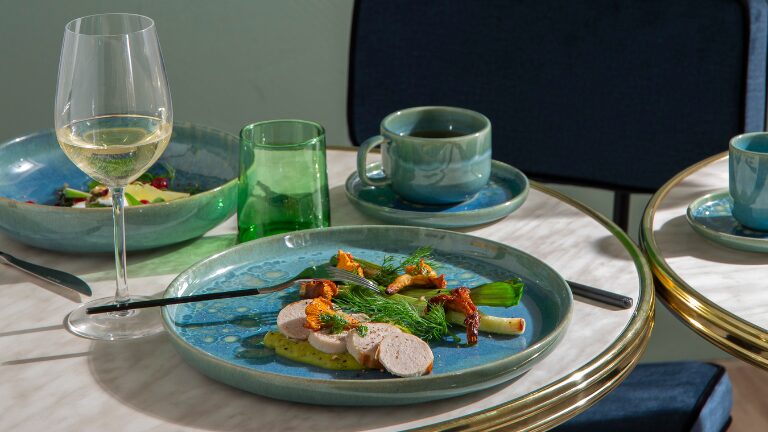Types of dishes and materials you can use in your restaurant
Looking for quality dishes made of a durable material that is easy to maintain on a daily basis? Depending on your establishment and the dishes you serve, you may need different materials or types of dinnerware. Here are some tips for choosing the right dinnerware.
What type of dish to choose according to the different meals you offer
✔︎ Presentation plates: with an approximate diameter of 30 cm, they are used to present main dishes or when a large capacity is needed. They can also be used as table decoration, to contrast and enhance smaller dishes.
✔︎ Deep plates: they are generally placed on a serving dish. They can be made of porcelain, stoneware or ceramic. The important thing is to choose a heat-resistant material. Nowadays there are many different shapes: round, square, octagonal, etc.
✔︎ Dessert plates: smaller than a standard plate, they have a diameter of approximately 20 cm. They are used to present cakes and pastries, but also serve as starters.
✔︎ Pasta plates: they are deep plates that usually measure 26 cm in diameter. Perfect for serving pasta, but also for risottos, meats in sauce, etc.
✔︎ Pizza plates: at 33 cm in diameter, they were designed for the size of pizzas. Flat plates, sometimes with a small rim to prevent the pizza from slipping, are usually white and made of a durable, easy-to-clean material.
✔︎ Bread plates: these are the smallest plates, along with the saucer. They are placed next to the fork on the table and can also be used to spread butter on bread. In some restaurants, they also serve as cheese plates.
Different materials for restaurant dishes
✔︎ Porcelain: this is the most common material when choosing plates for a restaurant. There is a wide variety of designs and it offers several advantages. Whether fine, white or patterned, it adapts to any environment.
✔︎ Stoneware: particularly appreciated by restorers, stoneware is a durable material that resists wear and scratches. Although heavier than porcelain, it adds a natural touch to the table. It is available in a wide variety of shades for added originality.
✔︎ Earthenware: this is the most economical ceramic. However, when using it, you may notice that the glaze begins to peel off the dishes. It is a relatively fragile material.
✔︎ Tempered glass: can be used intensively. Resistant, a tempered glass plate is ideal, for example, for a grill or a restaurant with a cozy atmosphere. Among its advantages, it keeps dishes at the right temperature during service.
✔︎ Enameled steel: this material is light, durable and unalterable. Pleasant to use, it brings a vintage touch to restaurant tables. Its advantages include maintaining the temperature of the dishes thanks to its thermal conductivity and its long life.
✔︎ Melamine: this material has the great advantage of being unbreakable. Lightweight and durable, it is often used for dinners on terraces or buffets. It is also the perfect material for barbecues or children’s birthday parties.
✔︎ Wood: a natural material, increasingly used in restaurant tables, especially in haute cuisine. It enhances colorful creations with vegetable elements as protagonists.
Note: the main difference between ceramic (such as earthenware) and porcelain lies in its resistance. A ceramic dish tends to chip more easily than a porcelain one, which lasts a long time despite intensive use. There is even a type of porcelain known as “hotel” that is particularly resistant.
How to properly care for your porcelain dishes?
Shocks are the main enemy of porcelain. Handle your dishes with care when setting the table and serving. When cleaning, avoid excessively high temperatures, even in the dishwasher. Ideally, wash porcelain dishes in lukewarm water. Adding a little bleach can help remove yellow stains before rinsing and rewashing with soap. Always dry them with a soft cloth.
At pilsa.com, you can find a wide selection of dishes for restaurants. Compare shapes, materials and even the different ranges.

